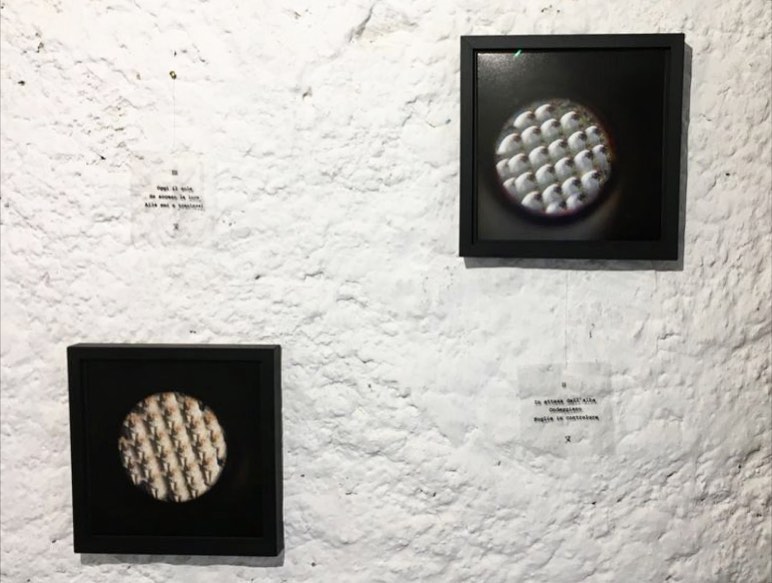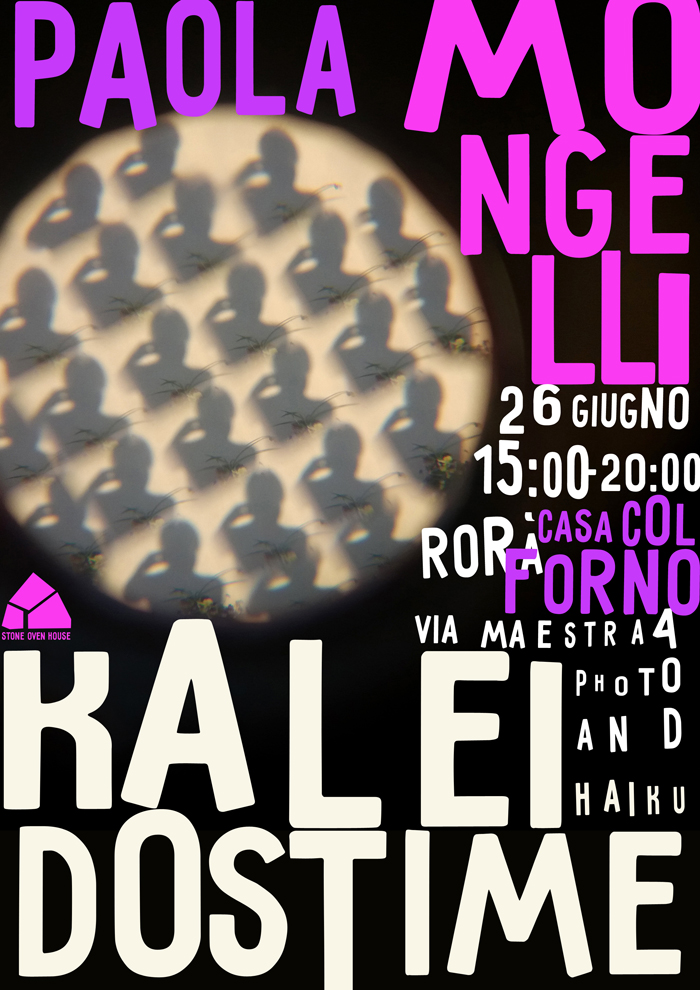
Kaleidos Time, Paola Mongelli
KALEIDOS TIME, NOSTALGIA OF THE PRESENT
AB At the beginning of March 2020, just before the health emergency and the lockdown, you had the intuition of a collective existential turning point, an unforeseen and obligatory condition of radical change in habits, of upsetting the habitual relationship with everyday life, with its rituals, objects, relationships. A feeling of loss that gave rise to what you called with an effective poetic oxymoron "nostalgia for the present", that is, a totally different, extraordinary perception of the ordinary. The chance encounter with a prismatic lens, bought from a stall, suggested the idea of looking through the lens of your camera through an intruder, an alien filter that transfigured the vision of objects and situations close to you: animals , plants, flowers, skies, floors, everyday objects ... How did you creatively experience this experience of perceptual transformation?
PM The first photograph is from March 1st, that evening an unusual restlessness pushed me to seek refuge in vision, in the creative gesture. When then the lockdown triggered, the primary feeling was that of living in a paradoxical condition: never feeling connected to the other as before, but in the impossibility of being together with others. The perception of being an isolated fragment, surrounded by nothingness, while living a common dimension. For me, the term "nostalgia" is linked to a condition of distance: I felt that everything was moving away, and capturing it in the unprecedented network of this "made-up" photographic eye gave me a very strong and also comforting emotion. Looking into this lens, I was struck by the possibility of reducing and fragmenting the size of the object being filmed, and at the same time multiplying it, with a virtually infinite expansion of the same fragment. The other aspect that interested me was the circular frame that isolated the single element, multiplying it into a sort of new autonomous planet, a world in which everything was concentrated, and which could act as a mirror to my solitary interiority. The world around me became just another planet, to be observed as though through a peephole, not so much with a voyeuristic eye but as an act of exploration and wonder, in that circle a mysterious compound appeared, which contained and evoked the colors and lights of spring, clues (and nostalgia) of familiar signs. Then the circular shape also reminded me of the disturbing figure of the coronavirus itself, and therefore the creative relationship with it became a kind of game to exorcise the fear of what appeared to be an enemy, try to listen, not to demonize ... extreme the poetics of the fragment, which in my work I have often sought, seen through this "magical" lens even the apparently most insignificant and negligible fragment revealed a new, surprising and sometimes moving nature.
AB The long experience of the lockdown has also changed the perception of time, expanding it and bringing it back to its cyclical origin, linked more to the alternation of day and night or to the seasons than to the tight scan to which professional and social life had accustomed us. In fact, you have selected and ordered, in retrospect, your images on the basis of an ideal day, which can repeat itself, in a cyclical time: 24 hours. To your 24 photographs you have associated 24 haiku, the ancient Japanese composition in 3 verses, which become the voice of the image, and tell the sensations, moment by moment, of this new existential, contemplative dimension. You have always written verses, but it is the first time that you systematically associate poetry with photography, how did you make your choice on this occasion?
PM These images were collected and put aside in spring 2020, but they needed time to be shared with others to fully mature their meaning within this new life cycle. I felt that these photographs were born from a strong movement of inner necessity, but I myself was not immediately ready to read the symbolism in all its aspects, I still had a partial vision of it. At the beginning of 2021 and close to the new spring, the images somehow awakened, reminding me of the experience of the previous year, and the same contemplative spirit that had given them birth is re-proposed in the form of writing, through the haiku. The essential form of the haiku offered a spontaneous correspondence with the aesthetics of the fragment that had guided my photographs, thus an inner dialogue between word and image was generated, in which the one brought out the deep, further meaning of other, without however explaining or arguing anything, indeed, in some respects, thickening the mystery, opening new paths of meaning, a multiplied sense like the fragment of the kaleidoscope. I also found a curious and casual correspondence: my kaleidoscope proposes the object in 24 parts!
Regarding contemplation, I would add that I wanted to complete this work with a video, a new language for me. Shot in a laundromat, it offers the observer an experience of contemplation of movement. It is also intended to be a tribute to Man Ray, his mobiles and automatic cinema, which focuses on looking without purpose, overcoming the need for narration. It is the way I have chosen to express that the antithesis between stillness and movement is actually illusory, as is the dimension of time. The century is no different from the instant, ant, man, star, in infinity they are the same, Giordano Bruno said this.
from a conversation with Andrea Balzola
Torre Pellice, June 2021
- welcome
- program
- 2025
- Bilzhofest. Talks and workshops (12–17.10)
- The New Orchestra. Exhibition at the National Mountain Museum (29.10)
- 5 elements. Yoga retreat (19.10)
- Logging Techniques with Mules — Festival Alpes Andes 2025 (17–18.10)
- Carovana del Canto — Festival Alpes Andes 2025 (8–13.09)
- Transumanza, sound ritual by and with Santa Cecilia & Semionauta (06.09)
- Kuthi. Puppet show for children and adults (25.08)
- Concert with the bees by Marna Fumarola and Azzurra Fragale (16.08)
- Ida Simone. Ciao Frabosano. Solo exhibition (16.08)
- Che Cine a Rorà – screening of Maske! (08.08)
- A Road for Georgia. Presentation of Elisa Baglioni’s book (26.07)
- Words and Music performance with Niccolò Piccinni and Leonardo Gallato (18.07)
- Wild and free. Creative retreat for women (04.07)
- Che Cine a Rorà! Outdoor film screening (27.06)
- Founded Beauty. Sculpture workshop with Manfred Kronenthaler (23.06)
- Concert by the participants of the Constellation Musical Maps workshop (08.06)
- Poetry evening with Alexander Delfinov and Sergio Garau (07.06)
- Constellations Musical Maps – Music Creation Workshop (06.06)
- Book presentation: Vertical Migrations. Andrea Membretti in conversation with Diego Mometti (10.05)
- Move me singing. Art retreat (25.04)
- Opera without rules. Group workshop (15.04)
- Poetry evening with Alexey Sosna (12.04)
- Change of State. Exhibition by Jane Sharvina (12.04)
- Visit for children to the exhibition “Abitare” by Anne Boscher (22.03)
- Abitare. Exhibition by Anne Boscher (08.03)
- Dragoljub Stankovikj. Chaos. (04.01)
- 2024
- Repair & Swap Day at Casa col Forno
- Performance con Lucciole
- Sinfonia Distante — Secret Open + Routing Ensample
- Il Sentiero si tratta camminando. Federico Basso
- Vignettes — Marc Standing
- About Becky — Dien Dien (Nadine Borst)
- Tra Due. Simon Lambrey
- KUTHI – A Mechanical Puppet Performance by Tricktrek Theatre Project
- Crocodile – A Puppet Performance by Tricktrek Theatre Project
- Mandril Reborn — Marc Ferrario
- Furia y Despegue — Enrique Morales, Diego Mometti, Federico Basso
- Musica Marziale — Matteo Tambussi & Cristina Ramat
- Repair & Swap Day at Casa col Forno
- Illustrated Cartography Workshop with Marina Demchenko
- Felicia Juno & Alan Lowles — Live Jazz Performance
- From Junk to Art — Workshop with Andrey Bilzho
- L’Abisso e L’Oasi — Guido Celli
- Furia y Despegue — Enrique Morales, Diego Mometti, Federico Basso
- Mapping Rorà — A Presentation with Marina Demchenko
- From Junk to Art — Workshop with Andrey Bilzho
- 2023
- Ekaterina Galaktionova. Cadavere Squisito
- Umano/Non Umano. Lev Nikitin
- “SOH Canta!” directed by Irmhild Wicking
- Ksenia Fedorova, Max Rudenko, Dannil Koronkevich.
- The Garden. Anna Tretyakova
- Open studio. Shamil Shaaev, Elena Horgan
- KASKAD. Project as Method
- Voices in Dialogue with the Elements
- Blue Reed Duo
- Sound performance. Gianni Grandi
- ABC — 2022. Andrey Bilzho
- Daniele Petti. Natural pigments. Workshop
- Gianni Denitto. Live saxophone and electronic
- Monica Perosino. La Neve di Mariupol. Book presentation
- East. Photographs by Alessandro Treggiari
- Katya Kabalina. Sensible objects
- Balovin and Beccato. In Kind Exchange
- Zoya Pilipenko. Puzzles. Open studio
- Lev Nikitin. Senso di Fame. Interactive performance
- Witness Trauma. Film screening and meeting with director Taya Zubova
- Transmorphing. Balovin&Beccato
- Religious/Political. Group exhibition of artists in residency
- 2022
- Ceramographics . Dragoljub David Stankovikj
- Conversation on the war in Ukraine and testimonies of resistance
- Kharkiv 2022. Kirill Gonchar. Photo chronicle of destroyed city
- Meeting with eyewitnesses of the war in Ukraine
- Matteo Tambussi. Concert supporting Ukraine
- Pisa: Ukraine and Russia. Art for Freedom.
- Open Studios. Italian, Ukrainian and Russian artists
- Lorenzo Gnata: Sulla Rotta
- Cristina Arnone: Conversations with trees, animals and human hart
- Gianni Pavan: Sounds and Silence of the Nature
- Daniil Shumikhin. Twenty Twenty Two
- Blu Polokkio
- 2021
- 2020
- Tarik Hanif. Florilegium
- Malacosa Teatro. Atypical Sung Variations.
- Jolin Lab. Stellaria
- Alessandro Sciaraffa, Daniele Galliano. «Stars and Flowers»
- Weaverbirds Collective. Aurora
- Vanja Vukovic. Exclusive Clouds
- Open studio with young artists: Laura Tolen, Jacqueline Hoefnagels, Molly Johnson, Nell Mitchell.
- Alexey Mironov. Bon Voyage
- La Pushkin
- 2019
- Anastasia Sukhareva-Morozova. Utitled
- Sergei Prokofiev. Place
- Lev Nikitin. Scotoma
- Matteo Tambussi. Live
- Beppe Giampà. Live
- Adrian Geller. I was pretty lucky
- Valdo Morel. Flash
- 20 Strings. Live
- Da ladno. Russian Folk
- Cynthia Fusillo. I Have All I Need
- Marta Zapparoli: Acoustic Sketch Portraits
- Erik Schou. Non Ci Sono Lucciole Senza Buio
- Ilaria Allegri. Live
- RednakS
- Stefano Fiori & Giuliano De Marco. Live Blues
- Animated movies
- Simon Lambrey. Being humans.
- Maximiliano Siñani. Apaccieta n.2
- Marina Skepner. My Shallow Roots
- 2018
- Sonic Picnic
- Die Dschunkel
- Iris Jans. Veranderen. Verschuiven
- The Trivettes Bluegrass Night
- Einar Breistrand Gerrard and Vovka Kozhekin
- Domestico — Selvatico
- Mitya Kharshak: Scaffolded City
- La Città delle Vedove di ClaudIo Celentano
- Jam with Dingo
- Con/Certo Senza Biglietto
- Harry Jones–Martin. Moving Semiotics — Language in The DigitaL Age
- Natalya Zaloznaya. The Model of a Failed Escape
- Bread and Jam
- Julia Belova: Mellow Yellow Swallows Bellow
- Makepop!
- The Cartoons You’ve Never Seen: Ivan Maximov, Leonid Shmellkhov and the others
- Camminare con Nicol Guerra
- Dragoljub David Stankovikj: Molitva
- Da Ladno!
- Vea
- Fabrizio Urbisaglia & Ivan Canello
- 2017
- Dragoljub David Stankovikj
- ManiaXXX
- The Crickets Under the Water
- The Cartoons You've Never Seen
- Import/Export
- Forno Filosofico
- Gingi Statman: Mattoni Matti
- Introduction to Meditation with Gian Luigi Cargnel
- Kombu Project
- Beppe Giampà
- Jam with Josephina Schiller
- Orphic Wind Van
- Con/Certo Senza Biglietto
- Ciento Lindo Party
- In Kind Exchange
- Olga Niconova
- Russian Authors Animation
- 2025
- stone oven house
- art residency
- neighbourhood
- donation
- contacts
- FAQ
- RU
- IT
